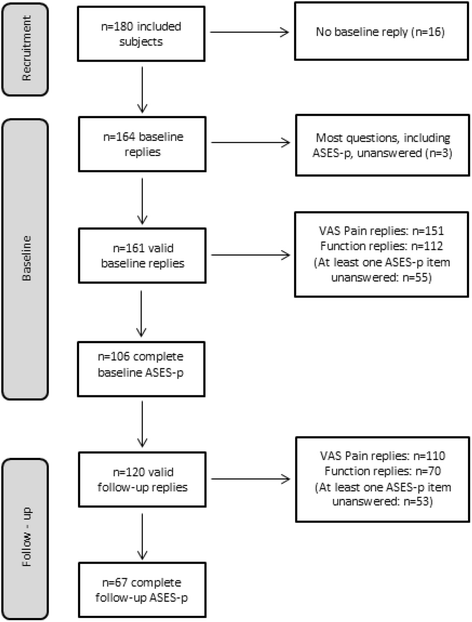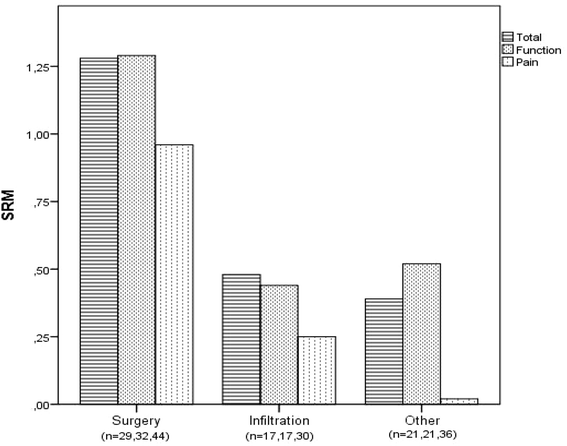Patient self-report section of the ASES questionnaire: a Spanish validation study using classical test theory and the Rasch model
- PMID: 27756317
- PMCID: PMC5070228
- DOI: 10.1186/s12955-016-0552-1
Patient self-report section of the ASES questionnaire: a Spanish validation study using classical test theory and the Rasch model
Abstract
Background: The aim of the current study was to validate the self-report section of the American Shoulder and Elbow Surgeons questionnaire (ASES-p) into Spanish.
Methods: Shoulder pathology patients were recruited and followed up to 6 months post treatment. The ASES-p, Constant, SF-36 and Barthel scales were filled-in pre and post treatment. Reliability was tested with Cronbach's alpha, convergent validity with Spearman's correlations coefficients. Confirmatory factor analysis (CFA) and the Rasch model were implemented for assessing structural validity and unidimensionality of the scale. Models with and without the pain item were considered. Responsiveness to change was explored via standardised effect sizes.
Results: Results were acceptable for both tested models. Cronbach's alpha was 0.91, total scale correlations with Constant and physical SF-36 dimensions were >0.50. Factor loadings for CFA were >0.40. The Rasch model confirmed unidimensionality of the scale, even though item 10 "do usual sport" was suggested as non-informative. Finally, patients with improved post treatment shoulder function and those receiving surgery had higher standardised effect sizes.
Conclusions: The adapted Spanish ASES-p version is a valid and reliable tool for shoulder evaluation and its unidimensionality is supported by the data.
Keywords: ASES-p; Confirmatory factor analysis; Constant Murley Score; Rasch model; Responsiveness; SF-36; Shoulder; Spanish validation; Validity.
Figures


Similar articles
-
Chinese version of the Constant-Murley questionnaire for shoulder pain and disability: a reliability and validation study.Health Qual Life Outcomes. 2017 Sep 18;15(1):178. doi: 10.1186/s12955-017-0752-3. Health Qual Life Outcomes. 2017. PMID: 28923113 Free PMC article.
-
Reliability and validity of the Finnish version of the American Shoulder and Elbow Surgeons Standardized Shoulder Assessment Form, patient self-report section.BMC Musculoskelet Disord. 2014 Aug 11;15:272. doi: 10.1186/1471-2474-15-272. BMC Musculoskelet Disord. 2014. PMID: 25112412 Free PMC article.
-
Spanish translation and cross-language validation of the American Shoulder and Elbow Surgeons Standardized Shoulder Assessment Form.J Shoulder Elbow Surg. 2021 Jan;30(1):151-157. doi: 10.1016/j.jse.2020.05.020. Epub 2020 Jun 9. J Shoulder Elbow Surg. 2021. PMID: 33317701
-
Cross-cultural adaptation and validation of the Argentine "American Shoulder and elbow surgeons, patient self-report section" questionnaire.Musculoskelet Sci Pract. 2019 Oct;43:37-44. doi: 10.1016/j.msksp.2019.05.010. Epub 2019 Jun 4. Musculoskelet Sci Pract. 2019. PMID: 31220777
-
Validity and reliability of the Portuguese version of the American Shoulder and Elbow Surgeons Standardized Shoulder Assessment Form.Rev Bras Reumatol. 2012 May-Jun;52(3):348-56. Rev Bras Reumatol. 2012. PMID: 22641589 English, Portuguese.
Cited by
-
Validity and reliability of the Greek version of the American Shoulder and Elbow Surgeons Standardized Shoulder Assessment Form.JSES Int. 2021 Jan 17;5(3):601-607. doi: 10.1016/j.jseint.2020.11.007. eCollection 2021 May. JSES Int. 2021. PMID: 34136877 Free PMC article.
-
A new self-assessment tool following shoulder stabilization surgery, the auto-Walch and auto-Rowe questionnaires.Knee Surg Sports Traumatol Arthrosc. 2023 Jul;31(7):2593-2601. doi: 10.1007/s00167-022-07290-y. Epub 2022 Dec 31. Knee Surg Sports Traumatol Arthrosc. 2023. PMID: 36586000 Free PMC article.
-
Psychometric analysis of the questionnaires for the assessment of upper limbs available in their Italian version: a systematic review of the structural and psychometric characteristics.Health Qual Life Outcomes. 2021 Nov 22;19(1):259. doi: 10.1186/s12955-021-01891-w. Health Qual Life Outcomes. 2021. PMID: 35078509 Free PMC article.
-
The Dutch version of the American Shoulder and Elbow Surgeons Standardized Shoulder Assessment Form is a reliable and valid questionnaire for shoulder problems.JSES Open Access. 2019 Sep 16;3(3):213-218. doi: 10.1016/j.jses.2019.06.002. eCollection 2019 Oct. JSES Open Access. 2019. PMID: 31709365 Free PMC article.
-
Long head of biceps tendon augmentation in rotator cuff repair enhances tendon healing, shoulder function and patient-reported outcomes one-year post-surgery.J Exp Orthop. 2024 Oct 10;11(4):e70033. doi: 10.1002/jeo2.70033. eCollection 2024 Oct. J Exp Orthop. 2024. PMID: 39391567 Free PMC article.
References
-
- M.T.Vicente-Herrero, L.Capdevilla Garcia, A.A.Lopez Gonzalez, M.V.Ramiraz Iñiguez de la Torre, editors. El hombro y sus patologías en medicina del trabajo. In: SEMERGEN, vol 35. 2009. p. 197–202.
Publication types
MeSH terms
LinkOut - more resources
Full Text Sources
Other Literature Sources

